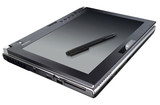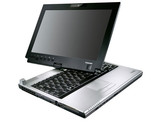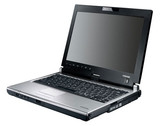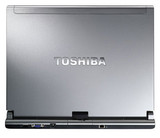Toshiba Portégé M750-10K
Especificaciones de Portátil(es)
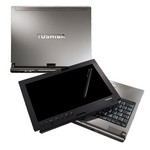
Price comparison
Promedio de 3 puntuaciones (de 4 análisis)
Análisis para el Toshiba Portégé M750-10K
Origen: Mobile Tech Review
 EN→ES Archive.org version
EN→ES Archive.org versionThe Toshiba Portege M750 is for those who want regular notebook power and design plus a tablet screen. It fits equally well in vertical markets such as medical, insurance, etc. and on the college or work campus. The notebook is powerful enough for most productivity applications, multimedia tasks and some gaming. It has plenty of ports, and built-in Wi-Fi and Bluetooth make sure you are connected wirelessly. The optical drive also sets it apart from the ultra-thin tablet notebooks and the display is very good by tablet PC standards.
Único Análisis, disponible online, largo, Fecha: 07/01/2009
Puntuación: Puntuación total: 70%
Origen: IT Reviews
 EN→ES Archive.org version
EN→ES Archive.org versionThere's plenty to like about the Portégé M750-10K: it's well-built, great to scribble notes on and has a reasonably fast processor. However, at just over £1,200 including VAT, it's also pretty expensive, so you need to be absolutely sure you'll make full use of its tablet features before parting with your cash. And although it's clearly aimed at business users, we were hoping for a slightly more stylish design.
Preis 40, Leistung 80, Verarbeitung 80
Único Análisis, disponible online, corto, Fecha: 05/26/2009
Puntuación: precio: 40% rendimiento: 80% procesamiento: 80%
Origen: Reg Hardware
 EN→ES Archive.org version
EN→ES Archive.org versionStill alive yet often ridiculed, tablet PCs haven't exactly had the easiest of times since their conception at the turn of the century. HP is attempting to breathe new life into the tablet by aiming its new TouchSmart TX2 at home users, but Toshiba's Portégé M750 takes a more traditional business-oriented approach. At £1206 inc VAT, the Portégé M750-10K doesn't come cheap, and at this price we were hoping for a better chassis. If you want to save a bit of cash, the M750-10J variation costs the least at £976, but with an Intel T5870 processor and just 1GB Ram, it's not something we're be tempted by.
70, Preis 40
Único Análisis, disponible online, largo, Fecha: 04/15/2009
Puntuación: Puntuación total: 70% precio: 40%
Origen: Techradar
 EN→ES Archive.org version
EN→ES Archive.org versionThe Toshiba Portégé M750-10K (£1233 inc. VAT) doesn't stray too far from the notion of what a Tablet PC should be and is clearly a machine designed for the businessman. The first thing you'll notice about this Tablet PC is how well made it is. The Toshiba Portégé M750-10K isn't the cheapest Tablet PC on the market, but it makes up for it with a great, if a little utilitarian, design, versatile performance and a highly usable battery life.
4 von 5, Leistung gut, Mobilität gut, Display schlecht
Único Análisis, , Longitud Desconocida, Fecha: 01/28/2009
Puntuación: Puntuación total: 80% rendimiento: 80% pantalla: 40% movilidad: 80%
Comentario
Intel Graphics Media Accelerator (GMA) 4500MHD: GPU integrado (memoria compartida) em el chipset GM45 (Montevina). Gracias a dos shaders más y una frecuencia de núcleo más alta, es mucho más rápido que el antiguo GMA X3100. Aun así, no es recomendable para jugadores (juegos DirectX 10 no son fluidos y pueden ser jugados sólo con configuraciones muy bajas). El procesador de video integrado es capaz de ayudar a decodificar videos HD (AVC/VC-2/MPEG2), como para una reproducción fluida de Blu-Ray con CPUs lentos.
Estos procesadores gráficos pueden mostrar únicamente juegos antiguos, fluidamente. Juegos actuales pueden ser presentados con detalles sustancialmente reducidos.
>> Más información puede ser encontrada en nuestra comparación de tarjetas gráficas moviles y la lista de benchmarks.
Intel Core 2 Duo: Este es el sucesor Core Duo y el Core Solo con un pipeline más largo y con una velocidad entre 5-20% sin mayor consumo de energía. Adicional al diseño de Core Duo existe un cuarto decodificador, una unidad SSE ampliada y una unidad lógica aritmética (ALU) adicional.
Sus características son: 2 núcleos (cores), una amplificación de comando de 64-bit EM64T y 2 o 4 MB L2 Cache y 291 millones de transistores, que son acabados en 65nm. Mas allá de esto, todos los tipos soportan técnicas "Execute Disable Bit", SSSE3 (SSE4), Enhanced Speedstep, LaGrande y la mayoría de técnicas de virtualizacion (VT) Vanderpool.
El Core 2 Duo para laptops es idéntico a los procesadores Core 2 Duo para desktops, pero los procesadores para notebooks trabajan con tensiones más bajas (0.95 a 1188 Volt) y un Frontside bus clock (1066 contra 667 MHz). El rendimiento de laptops cuena con una frecuencia de 20-25% más baja que PCs Desktop debido a una frecuencia más baja de Frontside bus y los discos duros más lentos.
P8400: CPU de gama media con un TDP de 25 vatios. Para juegos exigentes el rendimiento podría no ser suficiente (para tarjetas gráficas de clase 1).
>> Más información puede ser encontrada en nuestra comparación de procesadores móviles.




